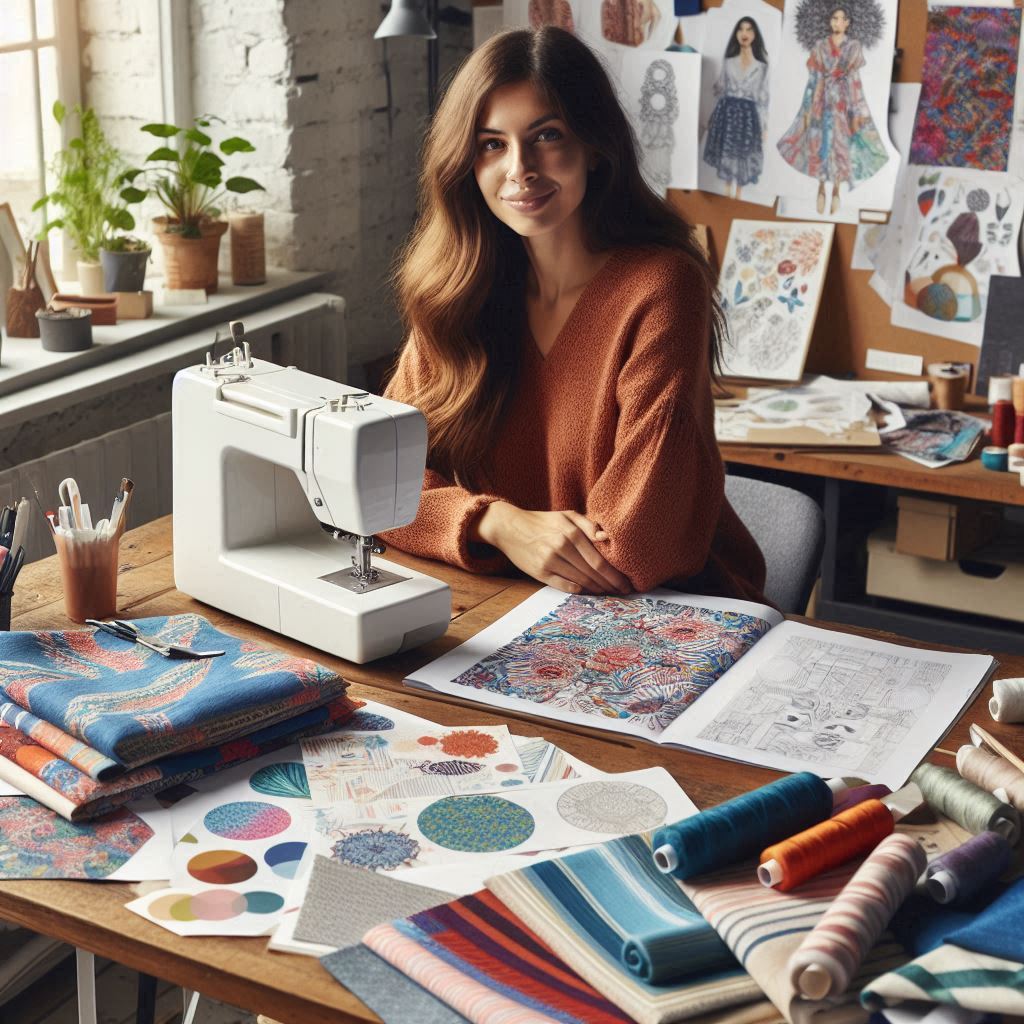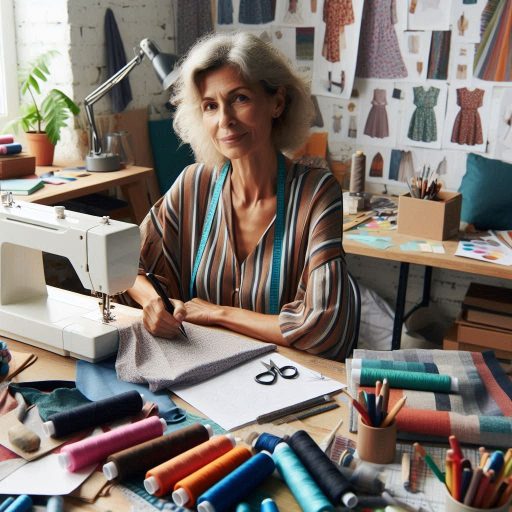Introduction
Textile design is the intricate art and science of creating patterns, prints, and textures for fabrics, used not only in fashion but also in interiors, home furnishings, and even industrial applications.
It is a creative discipline that merges artistic vision with technical skills, ensuring that fabrics are not only visually appealing but also functional.
At its core, textile design involves translating creative ideas into tangible products that consumers engage with every day, whether through clothing, upholstery, or various textiles in everyday life.
In the fashion industry, textile designers play an indispensable role.
They are the architects behind the very materials used to create garments, accessories, and other fashion items.
Without textile designers, fashion as we know it wouldn’t exist, as fabrics are the foundation upon which the entire industry is built.
Their contributions help shape seasonal collections, set trends, and define the mood and aesthetic direction of brands.
They create unique, innovative fabrics that allow fashion designers to bring their visions to life.
By choosing the right textures, colors, and patterns, textile designers can influence how garments feel, drape, and even perform in different conditions.
Whether designing for high-end couture or functional athletic wear, textile designers have a profound impact on the fashion landscape.
Beyond fashion, textile designers also contribute to a variety of industries, including interior design, home décor, and even automotive design.
However, their role in fashion remains particularly significant due to the fast-paced nature of the industry, where trends evolve rapidly, and consumer demands shift.
Textile designers ensure that fashion brands stay competitive by creating fabrics that are fresh, innovative, and aligned with market trends.
Educational Background Required
Degrees or Certifications Needed to Become a Textile Designer
To start a career as a textile designer, earning a degree in textile design or a related field is essential.
Common degree programs include fashion design, textile engineering, and fine arts.
These programs provide foundational knowledge in fabrics, patterns, and color theory.
Some employers may also accept certifications in textile design from recognized institutions, especially for specialized roles.
A degree or certification demonstrates your understanding of the core principles of textile design and ensures you’re well-prepared for the demands of the industry.
Importance of Having Knowledge in Various Design Techniques and Software
Knowledge of diverse design techniques is critical for textile designers.
Being proficient in weaving, printing, dyeing, and fabric structures gives you an edge in creating innovative designs.
Understanding the intricacies of these techniques ensures that your designs are not only creative but also technically feasible for production.
Additionally, mastery of design software like Adobe Photoshop, Illustrator, and CorelDRAW is now a standard requirement.
These tools allow you to create digital patterns efficiently, making it easier to share and adjust designs.
Knowledge of CAD (computer-aided design) software is also highly beneficial for designers working on complex patterns or large-scale production.
Skills Needed to Succeed in the Field
Success in textile design requires a blend of technical and soft skills.
Creativity is at the heart of the profession, enabling designers to produce fresh, unique ideas.
Alongside creativity, problem-solving skills help tackle challenges related to materials or production.
A keen eye for detail is essential, as even small errors can lead to costly mistakes in manufacturing.
Effective communication skills are equally important since textile designers often collaborate with manufacturers, clients, and team members.
Designers who can clearly communicate their ideas and collaborate efficiently are more likely to succeed in the industry.
Read: Networking Events for Costume Designers
Typical day-to-day tasks of a textile designer
Creating and Developing New Textile Designs
A typical day for a textile designer involves creating and developing new designs.
Designers sketch concepts, choose color schemes, and experiment with patterns that align with a brand or project.
They often use both traditional hand-drawing techniques and digital software like Adobe Illustrator or CAD programs.
The process involves constant refinement, testing fabrics, and adjusting designs to ensure they are visually appealing and functional for production.
Textile designers must consider both aesthetics and practicality in their work, ensuring that designs can be effectively woven or printed on various fabrics.
Collaborating with Fashion Designers and Manufacturers
Collaboration is a key part of a textile designer’s daily routine.
Designers frequently work alongside fashion designers, product developers, and manufacturers to ensure their textile creations fit within broader design collections or product lines.
This involves reviewing design specifications, understanding manufacturing limitations, and making adjustments to patterns or colors as needed.
Effective communication and teamwork are crucial during this process.
Designers must ensure their vision aligns with the production team’s capabilities, balancing creative ideas with technical feasibility.
Researching Trends and Staying Up-to-Date with the Latest Technologies
Staying ahead of trends and technology is another important aspect of a textile designer’s day.
Researching emerging trends in fabrics, textures, colors, and designs is vital to producing relevant and modern textiles.
Designers also need to keep up with advancements in textile manufacturing and design software.
Attending industry trade shows, reading fashion reports, and experimenting with new materials and technologies help designers remain competitive.
The textile industry is ever-evolving, and those who continuously adapt to new techniques and trends are better positioned for success.
Read: Famous Costume Designers in Hollywood
Salary and job outlook
Average Salary Range for Textile Designers
The salary for textile designers can vary depending on experience, location, and industry.
On average, textile designers earn between $45,000 and $75,000 per year.
Entry-level designers typically start on the lower end, while those with years of experience, specialized skills, or working in high-demand sectors can command higher salaries.
In major cities or with luxury brands, salaries may exceed $100,000 annually.
Freelance textile designers have more flexibility in their earnings, but this comes with the challenges of inconsistent work.
Potential for Growth and Advancement in the Field
Textile design offers considerable potential for growth and career advancement.
Designers who start in junior positions can move up to senior roles, including lead designer or creative director, as they gain experience.
Specializing in areas such as digital textile design, sustainable fabrics, or technical textiles can increase job prospects and earning potential.
Networking, developing a strong portfolio, and staying current with design trends and technologies can also open doors for career advancement.
Additionally, many textile designers choose to start their own design businesses or consult for multiple clients, offering more entrepreneurial opportunities.
Job Opportunities in Different Industries
Textile designers have opportunities in a range of industries beyond fashion.
The fashion industry remains a key employer, where designers create fabrics for clothing and accessories.
However, home décor is another major sector, where designers work on textiles for furniture, curtains, and bedding.
The automotive industry also offers roles for textile designers, focusing on interior fabrics and materials for car seats and panels.
Additionally, textile designers can find opportunities in sportswear, technical textiles, and even sectors like healthcare, where fabric innovation is essential.
This diversity of industries offers flexibility and varied career paths for textile designers.
Read: Visual Merchandiser: Job Market and Opportunities

Importance of creativity and innovation
How Creativity Plays a Vital Role in Textile Design
Creativity is at the heart of textile design.
Textile designers must consistently generate fresh ideas and concepts to create visually striking patterns and fabrics.
Creativity drives the development of unique textures, color combinations, and designs that distinguish a product or brand from its competitors.
Designers with a strong creative vision can push the boundaries of conventional textile design, bringing new life to fabrics and making a significant impact in the industry.
Whether it’s for fashion, home decor, or industrial use, creativity shapes how textiles look and function.
Ways Textile Designers Can Stay Innovative and Ahead of Trends
Staying innovative in textile design requires constant exploration and adaptation.
Designers can remain ahead of trends by researching emerging fabrics, studying fashion and design forecasts, and attending trade shows.
Experimenting with sustainable materials, digital printing techniques, or smart fabrics can also keep their work relevant.
Networking with other designers, participating in collaborations, and embracing new technologies such as 3D printing and CAD software further enable innovation.
Designers who maintain an open mindset and adapt to new ideas are better equipped to evolve with the ever-changing landscape of textile design.
Examples of Successful Textile Designers Who Have Made an Impact in the Industry
Several renowned textile designers have made a lasting impact on the industry through their creativity and innovation.
Zandra Rhodes, a British textile designer, became famous for her bold, vibrant patterns, transforming the fashion world with her unique style.
Meanwhile, American designer Sheila Hicks has pushed the boundaries of textile art through her groundbreaking work in weaving and fiber art, blending textiles with fine art.
On the sustainable front, designers like Stella McCartney are influencing the industry with their commitment to eco-friendly and ethical textile practices, showing how creativity and innovation can align with sustainability.
These designers illustrate how originality and foresight can leave a lasting mark on the textile design world.
Read: Visual Merchandiser: Job Market and Opportunities
Challenges faced by textile designers
Dealing with Tight Deadlines and High-Pressure Situations
Textile designers often face tight deadlines and high-pressure situations in their work.
Meeting production schedules is critical, especially when collaborating with fashion brands that rely on timely fabric deliveries.
Designers must balance their creative processes with the realities of time constraints.
This can lead to stress and require strong time management skills.
Effective organization and prioritization are essential to ensure that projects stay on track without sacrificing quality.
Designers must remain calm and focused under pressure, as last-minute changes can often arise.
Balancing Creativity with Commercial Appeal
Another significant challenge for textile designers is balancing creativity with commercial appeal.
While designers strive to create innovative and unique textiles, they must also consider market demands and client preferences.
Designs must resonate with consumers and fit within current trends, making it essential to find a sweet spot between artistic expression and commercial viability.
This requires designers to stay informed about market research, customer feedback, and industry trends.
Successfully navigating this balance ensures that their creations are not only beautiful but also sellable.
Navigating the Competitive Landscape of the Fashion Industry
The fashion industry is notoriously competitive, posing a challenge for textile designers.
With numerous designers vying for attention, standing out can be difficult.
Designers must develop a strong personal brand and a distinctive style to capture the interest of clients and consumers.
Networking, showcasing work through social media, and participating in industry events can help designers gain visibility.
Additionally, understanding the latest industry trends and technology is crucial for staying relevant.
To thrive in this competitive landscape, textile designers must continuously innovate and adapt while maintaining their unique creative vision.
Transform Your Career Today
Unlock a personalized career strategy that drives real results. Get tailored advice and a roadmap designed just for you.
Start NowOpportunities for specialization
Different Areas of Specialization Within Textile Design
Textile design offers several areas of specialization, allowing designers to focus on specific aspects of the field.
Common specializations include print design, fabric development, surface design, and technical textiles.
Designers can also choose to specialize in sustainable textiles, smart fabrics, or upholstery fabrics.
Each area requires unique skills and knowledge, enabling designers to tailor their expertise to specific market demands.
This focus can help them develop a niche, enhancing their professional identity and appeal to potential employers.
How Specializing Can Enhance Career Opportunities and Earnings
Specializing in a particular area of textile design can significantly enhance career opportunities and potential earnings.
Companies often seek out experts who can bring a deep understanding of specific textile processes or trends.
This demand for specialized skills can lead to more job openings and higher salaries.
For example, print designers who can create compelling patterns and graphics may command higher fees due to their unique skill set.
Specialization allows designers to position themselves as industry authorities, making them more attractive candidates for advanced roles or leadership positions.
Examples of Specialized Roles Such as Print Designer, Colorist, and Textile Researcher
Several specialized roles exist within the textile design field.
A print designer focuses on creating unique patterns and prints for fabrics, ensuring that their designs align with market trends and consumer preferences.
A colorist specializes in selecting and developing color palettes for textiles, playing a critical role in the overall aesthetic appeal of a product.
Meanwhile, a textile researcher examines the properties of various fabrics, investigating new materials and technologies to enhance textile production.
Each of these roles requires specific knowledge and skills, allowing designers to carve out successful careers in their chosen specialization.
Conclusion
The field of textile design presents a truly dynamic and rewarding career path for those with a passion for creativity, innovation, and artistic expression.
Throughout this blog post, we’ve delved into the key roles and responsibilities that a textile designer can expect to take on, from conceptualizing original designs and developing patterns to collaborating with manufacturers and staying current with trends.
Textile designers are at the heart of the creative process, transforming ideas into tangible products that influence industries ranging from fashion to home décor and beyond.
Aspiring textile designers should feel inspired to pursue their passion with confidence.
This field allows for endless opportunities to make a meaningful impact.
Whether it’s working in fashion, interior design, or technical textiles, there is immense potential to innovate and shape the aesthetics of the future.
Your designs can influence the way people live, dress, and experience their surroundings, offering a deeply satisfying creative outlet.
For those who dream of a career in textile design, it’s important to understand that this journey is not only about artistic talent but also about collaboration, adaptability, and a willingness to experiment.
The industry is fast-paced and ever-evolving, so textile designers must constantly push themselves to stay ahead of trends, embrace new techniques, and master cutting-edge technology.
[E-Books for Sale]
The Big Book of 500 High-Paying Jobs in America: Unlock Your Earning Potential
$19.99 • 500 High-Paying Jobs • 330 pages
Explore 500 high-paying jobs in America and learn how to boost your career, earn more, and achieve success!
See All 500 High-Paying Jobs of this E-Book
1001 Professions Without a Degree: High-Paying American Jobs You Can Start Now
$19.99 • 1001 Professions Without a Degree • 174 pages
Discover 1001 high-paying jobs without a degree! Unlock career tips, skills, and success strategies for just $19.99!




